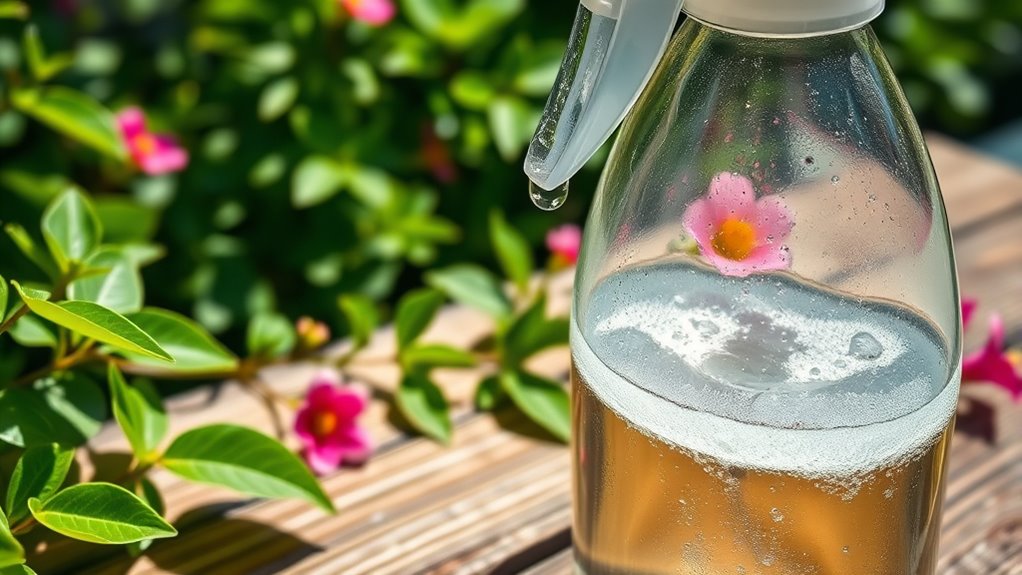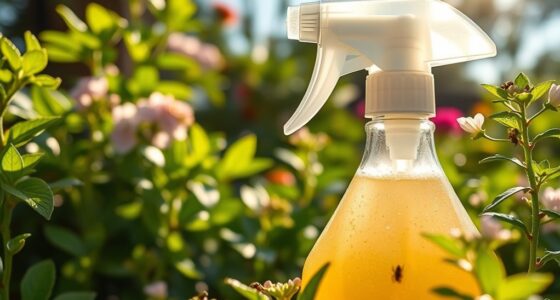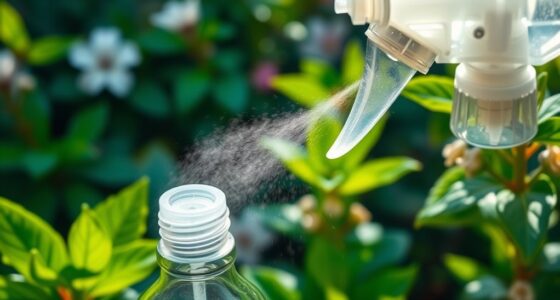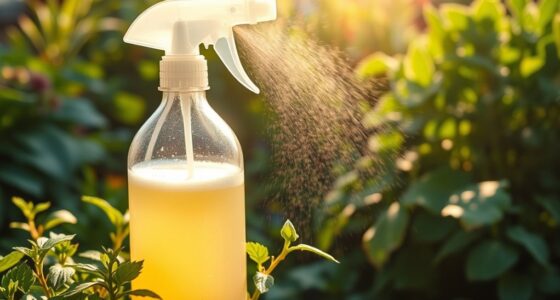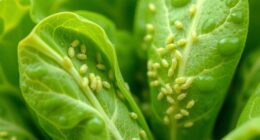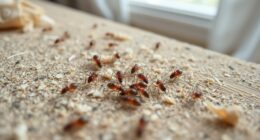A soap spray is a simple, eco-friendly way to combat soft-bodied pests like aphids and whiteflies in your garden. Mix 1-2 teaspoons of gentle liquid soap with a quart of water, then spray on affected plants, focusing on undersides of leaves. Apply during early morning or late evening and avoid overuse to protect beneficial insects. If you want to discover more about creating effective DIY pest control, keep exploring these tips.
Key Takeaways
- Use mild liquid soap or soap flakes mixed with water (1-2 teaspoons per quart) to create a safe, effective insecticide.
- Spray on affected plants, especially undersides of leaves, during early morning or late evening to protect beneficial insects.
- Test the soap spray on a small plant area first, and observe for 24 hours to prevent damage or stress.
- Target pest hotspots and avoid blanket spraying to maintain garden ecosystem balance and protect pollinators.
- Incorporate soap sprays as a sustainable, eco-friendly pest control method alongside natural predators for a healthy garden.
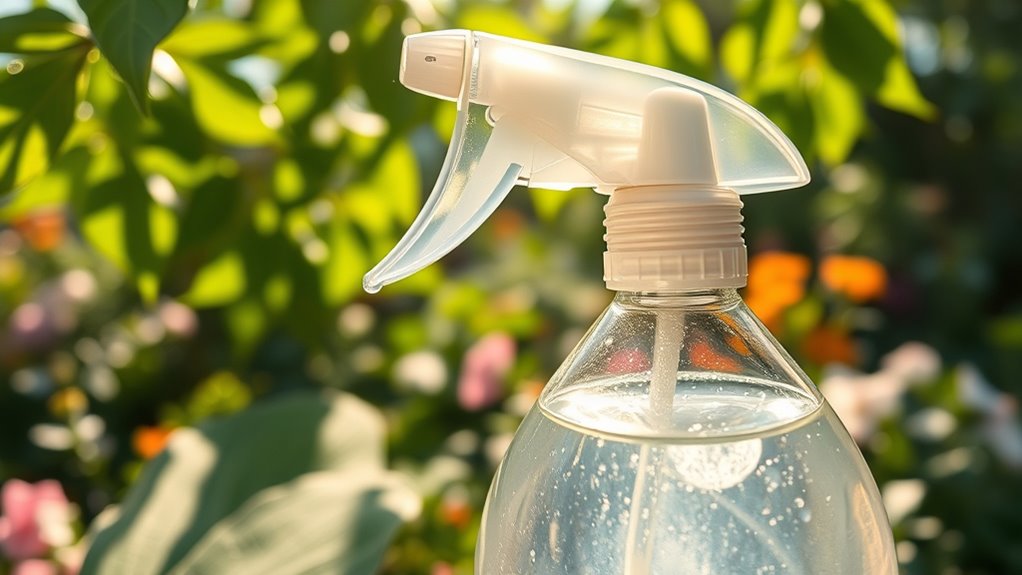
If you’re looking for an eco-friendly way to protect your garden from pests, making your own natural insecticide is a simple and effective solution. Soap sprays are a popular choice because they’re affordable, easy to prepare, and gentle on the environment. When used correctly, they can control soft-bodied pests like aphids, whiteflies, and spider mites without harming beneficial insects that help keep your garden balanced. By avoiding harsh chemicals, you also uphold pesticide safety, ensuring your garden remains a safe haven for pollinators and other helpful creatures.
To make a basic soap spray, you typically need just a few ingredients: mild liquid soap or soap flakes and water. You want to choose a soap that’s free of additives like fragrances, dyes, or degreasers, since these can damage plants or harm beneficial insects. Start by mixing about one to two teaspoons of soap per quart of water. Stir the mixture gently to prevent creating too many suds, which can clog spray nozzles. Once combined, pour the solution into a spray bottle for easy application.
Mix one to two teaspoons of gentle soap with a quart of water for an eco-friendly pest spray.
When applying your soap spray, it’s essential to target affected areas, focusing on the undersides of leaves where pests tend to hide. Spray during the early morning or late evening to minimize the risk to beneficial insects like bees and ladybugs that are most active during the day. Always test your spray on a small section of your plant first, waiting 24 hours to check for any adverse reactions. If the plant shows signs of stress, dilute your mixture further or try a different method.
Using soap sprays with pesticide safety in mind means avoiding overuse and applying them only when necessary. Over-spraying can harm beneficial insects, which are indispensable for natural pest control and pollination. The key is to strike a balance—target pest hotspots without blanket spraying your entire garden. Remember, beneficial insects help keep pest populations in check naturally, so preserving their presence is essential for a healthy garden ecosystem. Regular monitoring allows you to catch pest issues early, reducing the need for multiple applications and minimizing potential harm to the environment. Incorporating natural materials like wood and stone can also help create a more balanced and sustainable garden environment.
In essence, soap sprays offer a sustainable way to combat pests while respecting pesticide safety and supporting beneficial insects. They’re a simple, cost-effective tool that, when used thoughtfully, helps maintain a healthy garden where plants and beneficial creatures thrive together. With proper application, you can keep pests at bay without compromising the natural balance, making your garden a safe, vibrant space for all its inhabitants.
Frequently Asked Questions
How Often Should I Reapply Soap Sprays for Best Results?
You should reapply soap sprays based on the reapplication frequency that keeps pests at bay without harming plants. Typically, an ideal spray interval is every 7 to 10 days, but adjust if you notice pests returning or if weather conditions change. Keep an eye on your plants and pests, and reapply as needed to maintain effective control. Consistent timing ensures your soap spray remains a reliable natural insecticide.
Can Soap Sprays Harm Beneficial Garden Insects?
Like gentle rain nourishing your garden, soap sprays can protect without harm if you consider beneficial insect safety. While soap spray toxicity is generally low, it’s essential to apply carefully to avoid unintended harm. You’re the gardener guiding this delicate balance, ensuring your natural defenses target pests without disrupting helpful insects. With mindful use, you preserve the harmony that keeps your garden thriving, blending protection with respect for nature’s allies.
Are There Specific Soap Brands Recommended for Insecticide Use?
When choosing soap sprays, you might wonder about brand recommendations and soap formulation. Look for gentle, pure castile soaps or horticultural oils, as they’re less likely to harm beneficial insects. Avoid brands with added fragrances or dyes. Check labels for ingredients like potassium salts of fatty acids. Always test a small area first, and opt for formulations specifically designed for garden use to guarantee safety and effectiveness.
What Are Signs of Soap Spray Overuse on Plants?
Ever wondered if you’re overdoing it with soap sprays? Too much soap can cause plant stress, leading to leaf burn and yellowing. You might notice wilting leaves or a sticky residue that’s harmful instead of helpful. To avoid this, always follow recommended dilution rates and spray in the early morning or late evening. Monitoring your plants closely helps make sure you’re protecting them without causing damage.
Can Soap Sprays Be Used on Edible Vegetables Safely?
You can safely use soap sprays on edible vegetables if you follow proper guidelines. Always choose a mild, biodegradable soap to guarantee edible plant safety. Apply it during early morning or late evening, and rinse thoroughly after treatment to reduce soap spray residues. This minimizes any potential health risks, allowing your vegetables to stay healthy and safe for consumption while effectively controlling pests.
Conclusion
By mastering soap sprays, you hold the key to a garden that’s as vibrant as a blooming rainbow, free from harmful chemicals. Think of it as your trusty shield, quietly guarding your plants like a loyal guardian. With just a few simple ingredients, you turn your garden into a flourishing paradise—alive, healthy, and resilient. Embrace this natural weapon, and watch your garden thrive like a symphony conducted by your caring hands.
